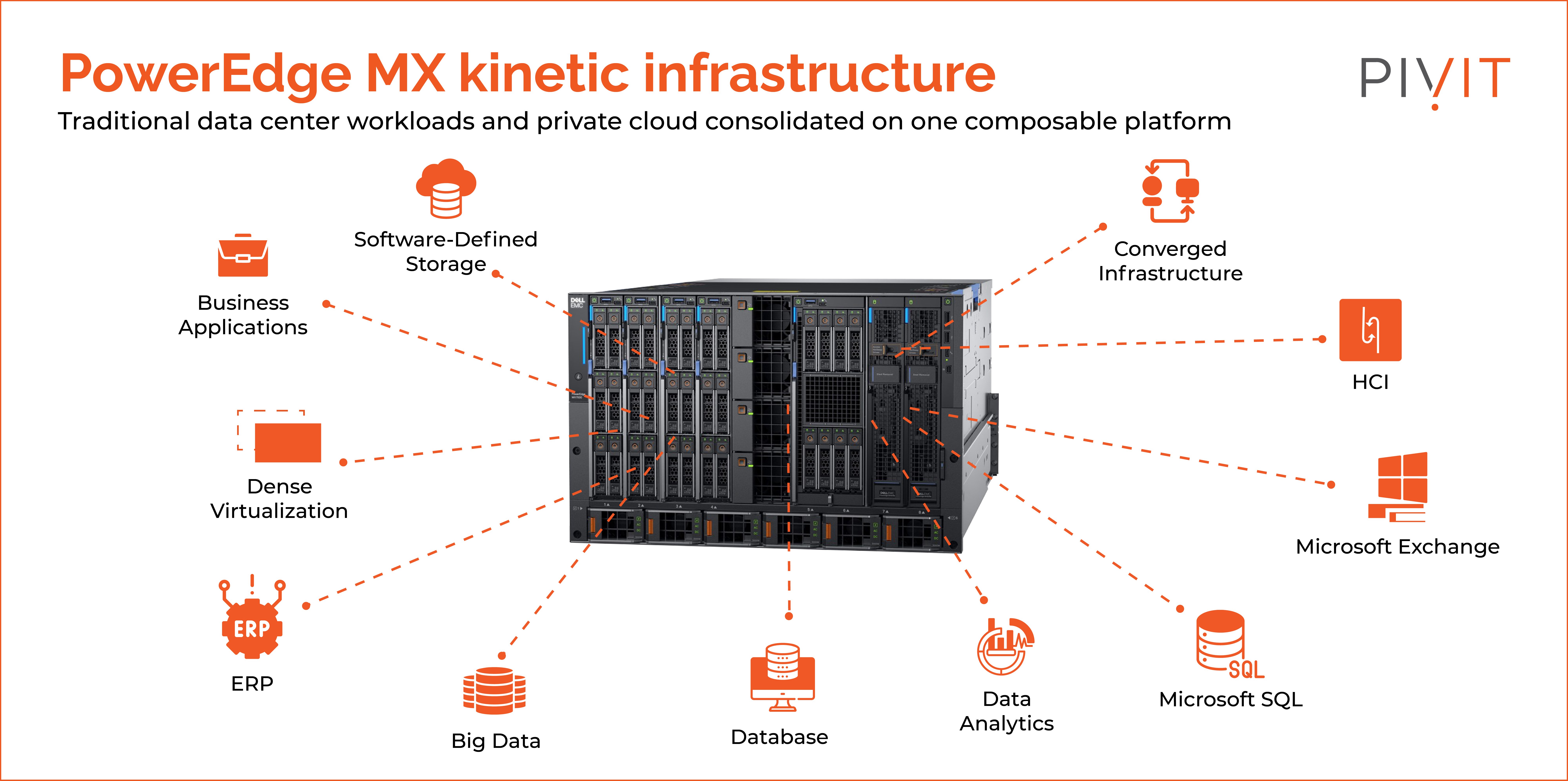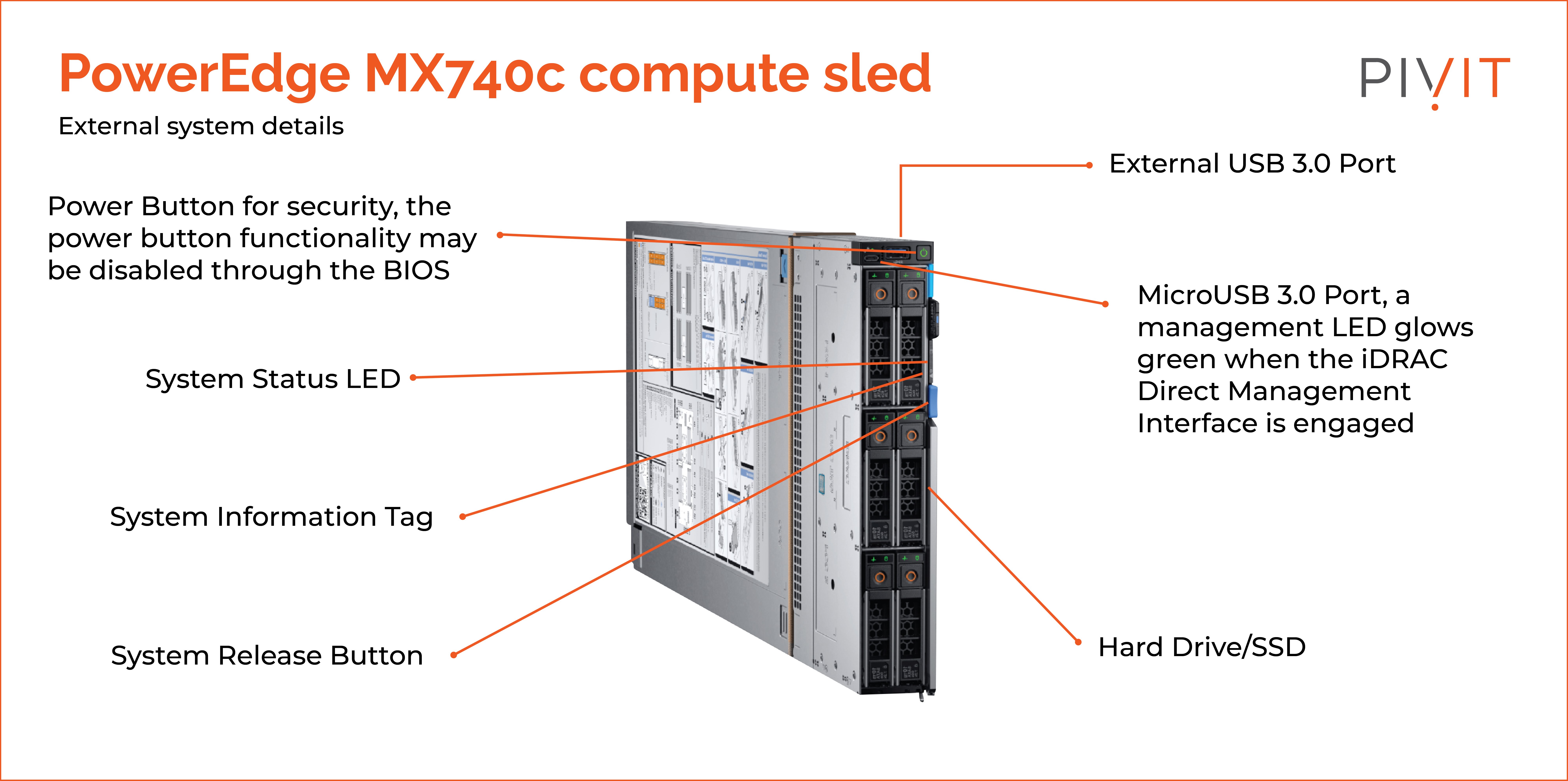The Perfect Pair: Dell EMC PowerEdge MX7000 & the MX740C Blade Server
.png)
For a mid-level or large-level organization, the blade server is the essential data center component. It gives flexibility, performance, and optimization for deployments in data centers, remote sites, and the cloud.
This blog will provide you with an overview of the Dell PowerEdge MX7000 modular chassis with its computing unit MX740C blade server. This kinetic infrastructure enables you to manage your on-premise or hybrid cloud infrastructure in a software-defined manner.
It can handle your ERP, big data solutions, fintech infrastructure, virtualization, and mobile applications with an outstanding total cost of ownership (TCO) ratio.
Already know what you need?
Dell EMC PowerEdge MX7000
You have two compute options when choosing the Dell EMC PowerEdge MX7000. Namely, the single-width Dell EMC PowerEdge MX740C with dual processors or the double-width Dell EMC PowerEdge MX840C with four processors.
The Dell EMC PowerEdge MX7000 Chassis can accommodate eight single-width PowerEdge MX740C or four double-width PowerEdge MX840C blade servers in 12Gbps single-width storage sled combinations. And you can use it as a combination of both.
Since Dell PowerEdge MX7000 does not have any backplane, all the server sleds, storage, and I/O modules are connected through expansion cards, giving much faster inter-connectivity. The MX740C sled connects directly to the fabric interface with redundancy through a direct orthogonal connection.
Dell EMC PowerEdge MX7000 Features
The Dell EMC PowerEdge MX7000 is the next-generation M1000E follow-on chassis and a revolutionary architecture set to be the future foundation of modular architecture supporting at least the next three generations of CPU technology. It features:
- Expanded storage options including up to 6 internal drives per two-socket compute sled (with M.2 boot options) and up to 16 granularly assignable 12Gbps SAS drives per storage sled.
- Support for up to 8 x two-socket compute sleds, 4 x four-socket compute sleds, or a mix.
- Up to 6 x 3000W power supplies with N+N redundancy and evenly distributed chassis-wide cooling.
- A fully redundant storage fabric for high availability supporting Fiber-Channel and SAS for traditional and emerging use cases.
- Two fully redundant general-purpose network fabrics with direct orthogonal connections to mezz cards make future upgradability extremely easy.
- The MX Scalable Fabric Architecture for multi-chassis networking up to 20 chassis.
- Expanded NVME PCIe SSD options (Dell Express Flash).
- A Quick Sync 2 technology option is available with the LCD using a Bluetooth secured point-to-point high-speed wireless connection.
- Empty chassis weight is approximately 105lbs. L10 min/max range estimate is between 180lbs and 400lbs.
- Dimensions in inches are 12.1 inches (height), 17.5 inches (width), 32 inches (depth).

Are these comparisons helpful? Be sure to subscribe to the Tech Corner on the right side of the screen so you get an email every time our expert technical writers have a new comparison.
Is there a comparison you'd like us to write about? Drop your suggestion in the comments below!
Dell EMC PowerEdge MX740C
Dell EMC PowerEdge MX740C server is a two-socket compute module that uses the second-generation Intel Xeon Scalable processors with up 56 threads and commits to giving support up to the next three generations of microprocessors. This is best for large or big data infrastructures because it supports 192 gigabytes of NVDIMMs in-memory databases.
Storage is on the front of the sled with six 2.5-inch storage bays that can support SAS or SATA HDDs or SSDs or U.2 PCI-E NVME drives. However, if you go with NVDIMs memory modules, you only have four drive bays available because of the additional battery required to protect the DIMMs during a power loss to preserve your upfront storage.
You can choose an M.2 boot optimized storage solution (BOSS) to increase the bootup speed. BOSS supports two M.2 drives and can be used to host your OS in mirror mode for redundancy, or you can install a dual SD card module (IDSD) for a hypervisor that features two SD cards.
Dell EMC PowerEdge MX740C Features
The PowerEdge MX740C, with dense, compute, large memory capacity, and rich set of storage subsystem options, is ideal for virtualization, collaborative and software-defined workloads in a 2-socket, single-width sled. A maximum of eight MX740C sleds can be installed in the PowerEdge MX7000 chassis.
- One or two, up to 28-core 2nd Generation Intel Xeon Scalable processors per sled, up to 448 cores per chassis.
- Up to 24 DDR4 DIMMs slots; configurations capacities of 8GB to 1.5TB (RDIMM) or 3TB (LRDIMM); support up to 192GB NVDIMM.
- Supports up to 12 slots for Intel Optane DC persistent memory DCPMM (6.1TB) with a maximum total capacity of 7.68TB per server.
- Up to six 2.5-inch drive bays for SAS/SATA (HDD/SDD) or Express Flash NVMe PCIe SSD drives plus optional M.2 boot capability.
- You can use iDRAC (Integrated Dell Remote Access Controller) to store the system firmware updates and patches for remote management.

Connectivity and Manageability Between the MX7000 and MX740C
The PERC and the BOSS both have a dedicated PCI slot on the system board and use the mini mezzanine connector to connect the storage fabric C. There are two redundant MX9002m Management Modules on the back of the chassis to control the overall chassis power, cooling, and physical user interfaces.
It supports the embedded management solution called the Dell OpenManage Enterprise Modular Edition (OME). QuckSync 2 and OpenManage are the options for the chassis management of the system.
Two I/O mezzanine cards at the rear of the sled are PCI 3.0 compatible and have dual ports for redundancy connecting to I/O fabrics A and B. The third PCI slot is a mini mezzanine slot that connects to the storage fabric C. The mezzanine cards connect directly to I/O fabric modules at the back of the MX7000 chassis, which can be configured for different connection network speeds using different modules.
Fabric C is currently used in SAS or fiber channel storage connectivity but is also future-ready to support next-generation technologies. The MX5016s storage sled uses fabric C to communicate directly with the I/O modules.
Top-Notch Benefits of the Dell EMC PowerEdge MX7000 and MX740C
MX7000 and MX740C are ideal for various workloads, including dense virtualization, software-defined workloads, software-defined storage, and hyper-converged infrastructure or big data environment.
- Well-equipped with power, cooling, centralized management, and high-performance I/O modules, MX7000 is quickly scalable for software-defined datacenter, and it has redundant power, networking, management, and storage fabric.
- PowerEdge MX7000 is a compact and flexible modular enclosure that supports up to four sockets per server sled with storage modules, and the network throughput will be the market-leading.
- PowerEdge MX740C can do more with less by taking advantage of more CPU cores with 2nd Generation Intel Xeon Scalable Processors, up to 28 cores per processor with Intel C628 Chipset.
- Dell EMC OpenManage systems management and iDRAC with Lifecycle controller will give you a single pane of glass to deploy, manage, monitor, update, and maintain any mission-critical large and complex infrastructure.
- The Dell PowerEdge MX740c blade server and the MX7000 blade chassis are the market-leading modular infrastructure solutions that reduce operational cost through economic power consumption with high computing and dynamic memory.
Which MX series has the majority of your attention? If you liked the way the MX740c stood up against the MX7000 chassis, you won't want to miss how the MX740c compares to Cisco's UCS B200 servers. Check out the comparison here. Most engineers have multiple OEMs in running when looking at purchasing equipment. This is why we believe it is best to know what hardware is the best fit within an OEM as well as across various OEMs. PivIT is here to help you make those comparisons and get the best gear in your data center.
At PivIT, we offer a fresh approach to sourcing, maintaining, and servicing your data center infrastructure. We’ve reimagined the status-quo and offer our customers strategies not found in the traditional IT channels. Our focus is to examine your CAPEX/OPEX limitations and present you with options to free up your budget, achieve your goals and Do IT Better.

